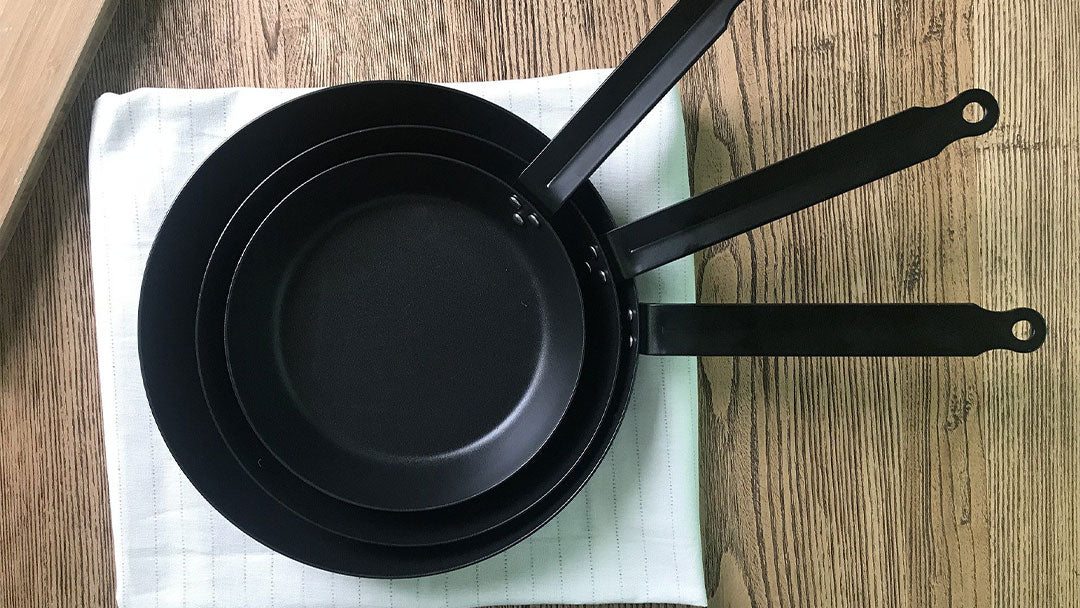Is Carbon Steel Cookware Safe for Cooking?
Safety is always a primary concern for both professional chefs and at-home cooks. When it comes time to choose cookware, you want to ensure it is made from non-toxic materials. Over the years, layers of the pots or pans can start to degrade, especially with certain types of materials. If you wonder whether carbon steel is safe for cooking, here are a few things that you will want to know.
Are you searching for high-quality carbon steel pans? Check out our durable and professional quality line of carbon steel products at de Buyer!
Is Carbon Steel Made With Toxic Materials?
Is Carbon Steel Better Than Cast Iron?
If you are trying to choose between cast iron or carbon steel, there are several pros and cons. Carbon steel is a more versatile option than cast iron. It heats up quicker than cast iron with fewer hot spots, allowing your foods to cook up more evenly. Carbon steel can also handle those temperature changes better than cast iron. You can switch from high heat to low heat in almost no time. With a cast iron pan, it will remain smoking long after you turn down the heat.
Another difference between cast iron and carbon steel is the weight. Carbon steel is lighter in weight, providing you with more maneuverability on the stovetop. For that reason, you will find carbon steel cookware in professional kitchens more than those heavy and bulky cast iron skillets. With its lightweight nature, you can easily shake and flip the pan. In addition to that, you can easily move carbon steel from the stovetop to the oven (and vice versa).
Related: Saute Pan Buying Guide
Is Carbon Steel Safe for Cookware?
Today, there are a bunch of materials to choose from for your cookware. Stainless clad, copper cookware, cast iron, and carbon steel are some of the most popular options. As long as you follow the care and use instructions for the cookware, they are safe to use. However, if you want a material that can tolerate those highest levels of heat (1200°F), carbon steel cookware is the best option.
Over the years, non-stick cookware has been the center of many health-related debates, especially with the different coating options. There are two types of non-stick coatings: Polytetrafluoroethylene (PTFE) and ceramic. While both ceramic and PTFE are deemed safe, PTFE is the better choice. When these pans are heated, they will not release any substance into the air.
One thing to keep in mind is if you want cookware with any type of coating, then stainless steel or carbon steel makes a great option. Carbon steel handles a high level of heat, and it will have a non-stick surface with regular use. If you are not worried about the non-stick or seasoning qualities of carbon steel, there is an alternative to carbon steel. Stainless clad is an excellent option for those chefs and cooks.
What Can You Cook in Carbon Steel?
You can cook almost anything in a carbon steel pan, however, there are a few limitations. Some ingredients can impact the seasoning of the pan. Vinegar, tomatoes, wine, and citrus are known to strip out the seasoning on the cookware's surface. After use of acids in a carbon steel pan, the seasoning does deteriorate, but that is a natural process of cooking. The pan is not ruined, but you will need to add another layer of seasoning to your cookware.
There are two ways to season a carbon steel pan: oven seasoning or on the stovetop. You will need to add a layer of oil and place the pan over high on the stove or in the oven. If your carbon steel pan looks dry, then it is time to give it a little love with a very thin layer of oil. For those pans with a heavy layer of seasoning, then you might not need to worry about acidic food stripping away that coating.
Related: Stainless Steel VS Copper Cookware
The Bottom Line
Is carbon steel safe? If you are concerned about the safety of carbon steel cookware, there is no need to worry. Carbon steel is extremely safe, and it is a great way to cook plenty of dishes. They can achieve non-stick tendencies with regular use, have the ability to handle high heat, and can be easily maneuvered on the stove. Carbon steel is quickly becoming one of the most trusted pieces of cookware in all types of kitchens.
Do you want to add some exceptional carbon steel cookware to your kitchen? At de Buyer, we have an extensive line of carbon steel products, including crepe pans, fry pans, omelet pans, and much more!


